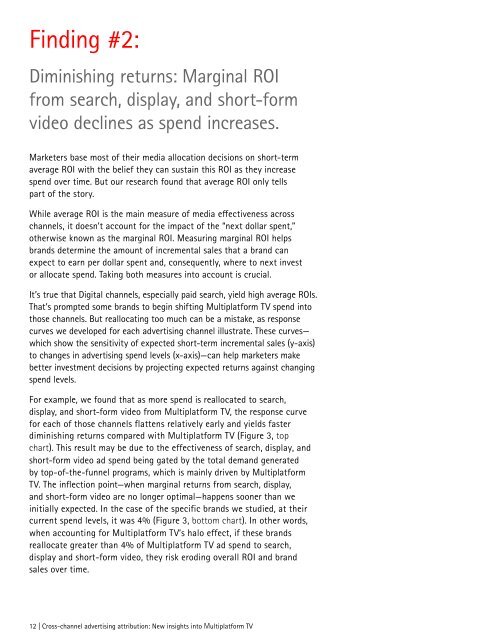Cross-channel advertising attribution New insights into Multiplatform TV
Cross-Channel-Advertising-Attribution_Accenture
Cross-Channel-Advertising-Attribution_Accenture
Create successful ePaper yourself
Turn your PDF publications into a flip-book with our unique Google optimized e-Paper software.
Finding #2:<br />
Diminishing returns: Marginal ROI<br />
from search, display, and short-form<br />
video declines as spend increases.<br />
Marketers base most of their media allocation decisions on short-term<br />
average ROI with the belief they can sustain this ROI as they increase<br />
spend over time. But our research found that average ROI only tells<br />
part of the story.<br />
While average ROI is the main measure of media effectiveness across<br />
<strong>channel</strong>s, it doesn’t account for the impact of the “next dollar spent,”<br />
otherwise known as the marginal ROI. Measuring marginal ROI helps<br />
brands determine the amount of incremental sales that a brand can<br />
expect to earn per dollar spent and, consequently, where to next invest<br />
or allocate spend. Taking both measures <strong>into</strong> account is crucial.<br />
It’s true that Digital <strong>channel</strong>s, especially paid search, yield high average ROIs.<br />
That’s prompted some brands to begin shifting <strong>Multiplatform</strong> <strong>TV</strong> spend <strong>into</strong><br />
those <strong>channel</strong>s. But reallocating too much can be a mistake, as response<br />
curves we developed for each <strong>advertising</strong> <strong>channel</strong> illustrate. These curves—<br />
which show the sensitivity of expected short-term incremental sales (y-axis)<br />
to changes in <strong>advertising</strong> spend levels (x-axis)—can help marketers make<br />
better investment decisions by projecting expected returns against changing<br />
spend levels.<br />
For example, we found that as more spend is reallocated to search,<br />
display, and short-form video from <strong>Multiplatform</strong> <strong>TV</strong>, the response curve<br />
for each of those <strong>channel</strong>s flattens relatively early and yields faster<br />
diminishing returns compared with <strong>Multiplatform</strong> <strong>TV</strong> (Figure 3, top<br />
chart). This result may be due to the effectiveness of search, display, and<br />
short-form video ad spend being gated by the total demand generated<br />
by top-of-the-funnel programs, which is mainly driven by <strong>Multiplatform</strong><br />
<strong>TV</strong>. The inflection point—when marginal returns from search, display,<br />
and short-form video are no longer optimal—happens sooner than we<br />
initially expected. In the case of the specific brands we studied, at their<br />
current spend levels, it was 4% (Figure 3, bottom chart). In other words,<br />
when accounting for <strong>Multiplatform</strong> <strong>TV</strong>’s halo effect, if these brands<br />
reallocate greater than 4% of <strong>Multiplatform</strong> <strong>TV</strong> ad spend to search,<br />
display and short-form video, they risk eroding overall ROI and brand<br />
sales over time.<br />
12 | <strong>Cross</strong>-<strong>channel</strong> <strong>advertising</strong> <strong>attribution</strong>: <strong>New</strong> <strong>insights</strong> <strong>into</strong> <strong>Multiplatform</strong> <strong>TV</strong>


